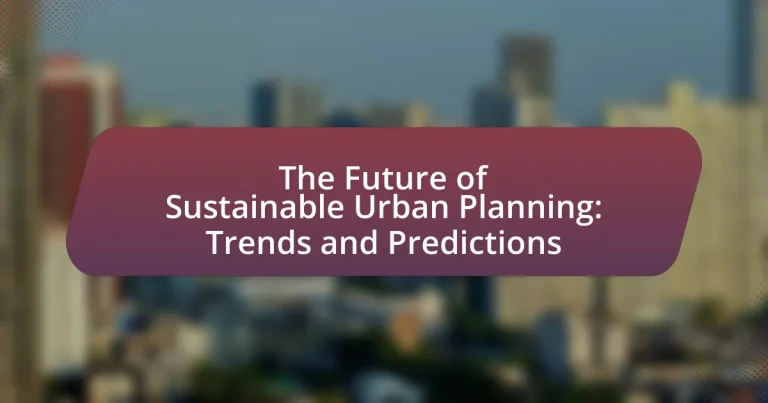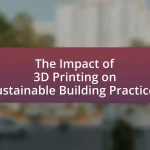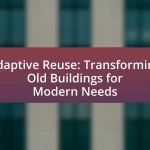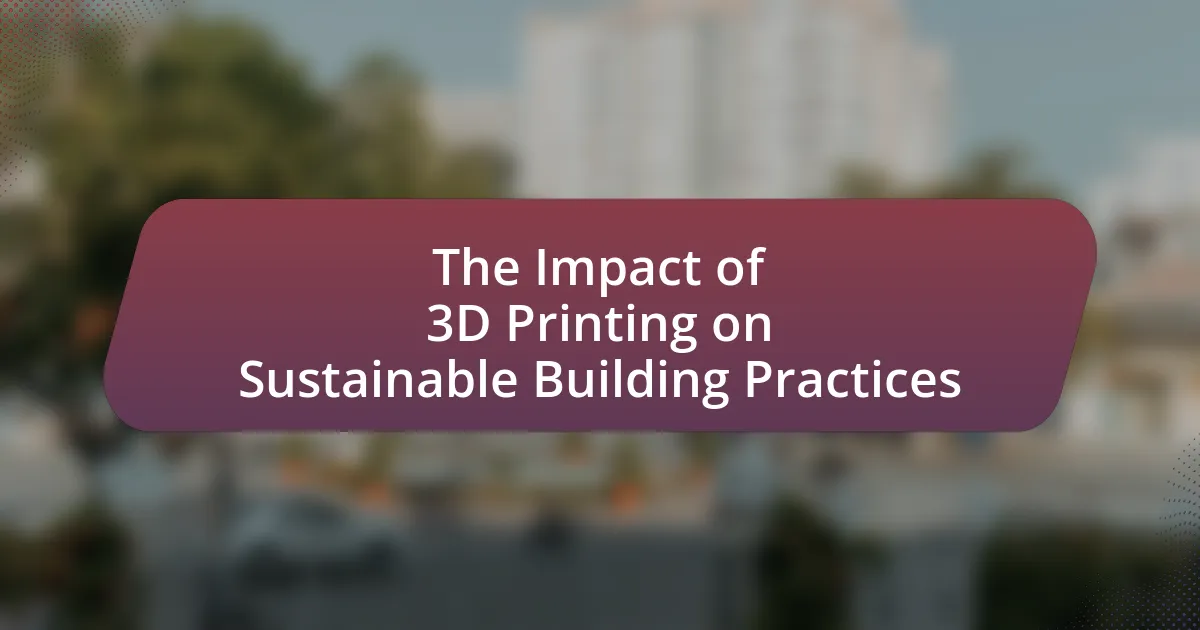The article focuses on the future of sustainable urban planning, emphasizing the integration of technology, resilience, and community well-being. It defines sustainable urban planning as a process that balances environmental, social, and economic needs, highlighting key principles such as environmental sustainability, social equity, and community engagement. The article contrasts sustainable urban planning with traditional approaches, discusses its importance for future cities, and outlines current trends, challenges, and best practices. Additionally, it explores the role of technology and community participation in shaping effective urban planning strategies, providing insights into how cities can adapt to demographic shifts and environmental challenges.
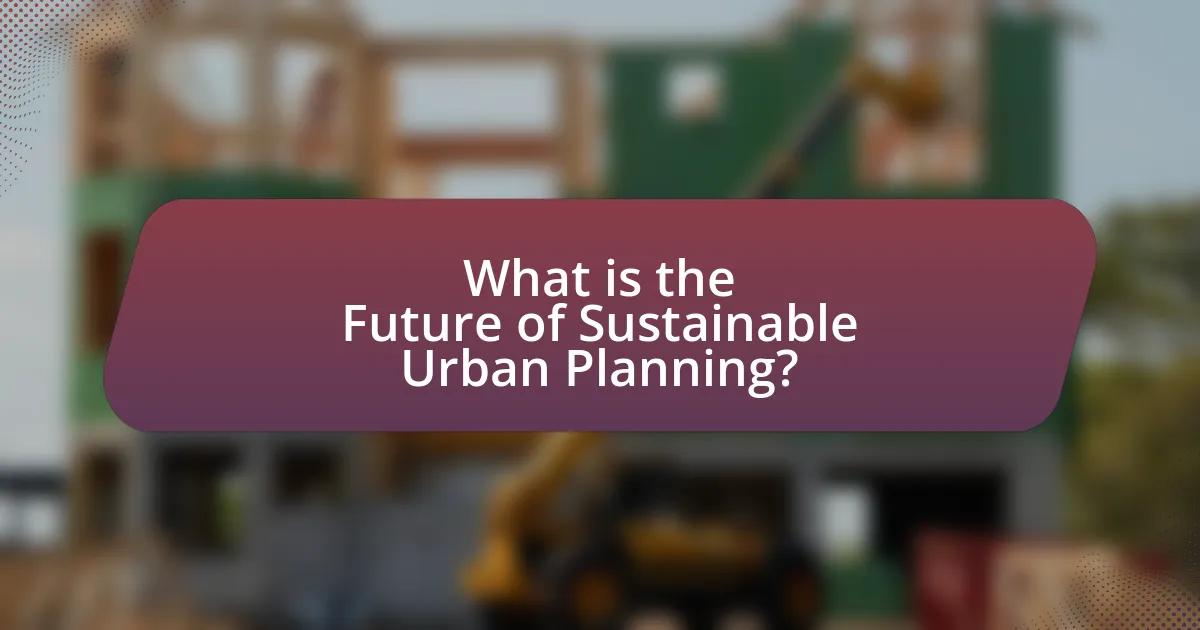
What is the Future of Sustainable Urban Planning?
The future of sustainable urban planning involves integrating technology, enhancing resilience, and prioritizing community well-being. Urban planners are increasingly adopting smart city technologies, such as IoT and data analytics, to optimize resource management and reduce environmental impact. For instance, cities like Barcelona have implemented smart lighting and waste management systems that significantly lower energy consumption and improve efficiency. Additionally, the focus on resilience is growing, with cities like New York investing in green infrastructure to mitigate climate change effects, as evidenced by the $20 billion allocated for coastal protection post-Hurricane Sandy. Furthermore, community engagement is becoming essential, with participatory planning processes ensuring that urban development meets the needs of diverse populations, as seen in initiatives like the “People’s Plan” in Los Angeles. These trends indicate a shift towards more adaptive, inclusive, and environmentally conscious urban environments.
How is sustainable urban planning defined in contemporary contexts?
Sustainable urban planning in contemporary contexts is defined as the process of designing and managing urban spaces to meet the needs of the present without compromising the ability of future generations to meet their own needs. This approach integrates environmental, social, and economic considerations to create resilient, inclusive, and efficient urban environments. For instance, the United Nations’ Sustainable Development Goals emphasize the importance of sustainable cities and communities, highlighting the need for urban planning that promotes resource efficiency, reduces carbon footprints, and enhances quality of life.
What are the key principles of sustainable urban planning?
The key principles of sustainable urban planning include environmental sustainability, social equity, economic viability, and community engagement. Environmental sustainability focuses on minimizing ecological impact through green spaces, efficient resource use, and reducing carbon footprints. Social equity ensures that all community members have access to essential services and opportunities, promoting inclusivity. Economic viability emphasizes creating a robust local economy that supports jobs and sustainable growth. Community engagement involves involving residents in the planning process to reflect their needs and aspirations. These principles are supported by frameworks such as the United Nations Sustainable Development Goals, which advocate for sustainable cities and communities.
How does sustainable urban planning differ from traditional urban planning?
Sustainable urban planning prioritizes environmental health, social equity, and economic viability, while traditional urban planning often focuses primarily on economic growth and infrastructure development. Sustainable urban planning incorporates strategies such as green building practices, renewable energy integration, and efficient public transportation systems to minimize ecological impact, as evidenced by cities like Copenhagen, which has implemented extensive cycling infrastructure and renewable energy sources, resulting in a significant reduction in carbon emissions. In contrast, traditional urban planning may overlook these aspects, leading to increased pollution and social disparities.
Why is sustainable urban planning important for future cities?
Sustainable urban planning is crucial for future cities because it addresses environmental, social, and economic challenges while promoting resilience and quality of life. By integrating green spaces, efficient public transportation, and renewable energy sources, sustainable urban planning reduces carbon footprints and enhances urban livability. For instance, cities that adopt sustainable practices can decrease greenhouse gas emissions by up to 30%, as evidenced by the Global Covenant of Mayors for Climate and Energy. This approach not only mitigates climate change impacts but also fosters community well-being and economic growth, making it essential for the development of future urban environments.
What environmental challenges does sustainable urban planning address?
Sustainable urban planning addresses several environmental challenges, including air pollution, water management, waste management, and habitat preservation. Air pollution is mitigated through the promotion of public transportation and green spaces, which reduce vehicle emissions and improve air quality. Water management challenges are tackled by implementing sustainable drainage systems and rainwater harvesting, which help manage stormwater and reduce flooding risks. Waste management is improved through strategies that promote recycling and composting, thereby minimizing landfill use and reducing greenhouse gas emissions. Lastly, habitat preservation is prioritized by integrating natural areas into urban designs, which supports biodiversity and ecosystem services. These approaches collectively contribute to creating resilient urban environments that can adapt to climate change and enhance the quality of life for residents.
How does sustainable urban planning contribute to social equity?
Sustainable urban planning contributes to social equity by ensuring that all community members have access to essential services, affordable housing, and public spaces. This approach prioritizes inclusivity, allowing marginalized groups to participate in decision-making processes and benefit from urban development. For instance, cities that implement mixed-income housing policies can reduce economic segregation, as seen in cities like Vienna, where 60% of residents live in subsidized housing, promoting diverse communities. Additionally, sustainable urban planning often incorporates green spaces and public transportation, which enhances accessibility for low-income populations, thereby fostering a more equitable urban environment.
What are the current trends shaping sustainable urban planning?
Current trends shaping sustainable urban planning include the integration of green infrastructure, smart city technologies, and community engagement. Green infrastructure, such as green roofs and permeable pavements, enhances urban resilience to climate change by managing stormwater and improving air quality. Smart city technologies leverage data and connectivity to optimize resource use and enhance urban services, with examples including energy-efficient buildings and intelligent transportation systems. Community engagement ensures that urban planning reflects the needs and desires of residents, fostering social equity and inclusivity. These trends are supported by research indicating that cities adopting these practices experience improved environmental outcomes and enhanced quality of life for residents.
How is technology influencing sustainable urban planning practices?
Technology is significantly influencing sustainable urban planning practices by enabling data-driven decision-making and enhancing resource efficiency. Smart city technologies, such as IoT sensors and data analytics, allow urban planners to monitor environmental conditions, traffic patterns, and energy usage in real-time, leading to more informed planning decisions. For instance, cities like Barcelona have implemented smart lighting systems that reduce energy consumption by 30% while improving public safety. Additionally, Geographic Information Systems (GIS) facilitate spatial analysis, helping planners visualize land use and optimize green spaces, which contributes to biodiversity and urban resilience. These technological advancements not only improve the sustainability of urban environments but also promote community engagement through platforms that allow residents to participate in planning processes.
What role do community engagement and participation play in sustainable urban planning?
Community engagement and participation are crucial in sustainable urban planning as they ensure that the needs and preferences of residents are integrated into development processes. This involvement leads to more effective and equitable urban solutions, as evidenced by studies showing that projects with community input are more likely to meet local needs and achieve long-term sustainability goals. For instance, the American Planning Association highlights that community-driven initiatives often result in higher satisfaction rates and better environmental outcomes, demonstrating the tangible benefits of inclusive planning practices.
How can we predict the future of sustainable urban planning?
Predicting the future of sustainable urban planning involves analyzing current trends, technological advancements, and policy frameworks. Urban planners can utilize data analytics and modeling tools to forecast the impacts of various sustainability initiatives, such as green infrastructure and energy-efficient buildings. For instance, a study by the American Planning Association highlights that cities implementing smart growth strategies have seen a 20% reduction in greenhouse gas emissions. Additionally, integrating community feedback through participatory planning processes can enhance the relevance and effectiveness of sustainable urban strategies. These methods provide a structured approach to anticipate future needs and challenges in urban environments.
What emerging technologies are likely to impact sustainable urban planning?
Emerging technologies likely to impact sustainable urban planning include smart sensors, artificial intelligence (AI), and blockchain. Smart sensors facilitate real-time data collection on environmental conditions, enabling cities to optimize resource use and reduce waste. AI enhances decision-making processes by analyzing vast datasets to predict urban growth patterns and assess the impact of various planning scenarios. Blockchain technology offers transparency and security in transactions related to urban development, fostering trust among stakeholders and streamlining processes. These technologies collectively contribute to more efficient, resilient, and sustainable urban environments.
How do demographic shifts influence future urban planning strategies?
Demographic shifts significantly influence future urban planning strategies by altering population density, age distribution, and cultural diversity. As urban areas experience population growth, planners must adapt infrastructure, housing, and services to accommodate increased demand. For instance, the United Nations projects that by 2050, 68% of the global population will live in urban areas, necessitating expanded public transportation and housing solutions. Additionally, an aging population requires planners to consider accessibility and healthcare facilities, while increasing cultural diversity calls for inclusive public spaces and community services. These factors compel urban planners to develop flexible, sustainable strategies that address the evolving needs of diverse populations.
What challenges might sustainable urban planning face in the future?
Sustainable urban planning may face challenges such as climate change, resource scarcity, and socio-economic disparities. Climate change can lead to increased flooding, heatwaves, and other extreme weather events, which complicate infrastructure resilience and urban design. Resource scarcity, particularly in water and energy, can hinder the implementation of sustainable practices and technologies. Additionally, socio-economic disparities may result in unequal access to sustainable amenities and services, creating divisions within urban populations. These challenges necessitate innovative solutions and collaborative approaches to ensure effective sustainable urban planning in the future.
How can policymakers address potential obstacles to sustainable urban planning?
Policymakers can address potential obstacles to sustainable urban planning by implementing integrated policy frameworks that promote collaboration among stakeholders. This approach ensures that urban development aligns with environmental, social, and economic goals. For instance, cities like Copenhagen have successfully integrated cycling infrastructure into their urban planning, resulting in a 62% reduction in carbon emissions from transportation since 1995. By fostering partnerships between government, private sector, and community organizations, policymakers can effectively navigate challenges such as funding limitations, regulatory barriers, and public resistance.
What role does funding play in the future of sustainable urban planning?
Funding is crucial for the future of sustainable urban planning as it enables the implementation of innovative projects and technologies that promote environmental sustainability. Adequate financial resources allow cities to invest in green infrastructure, such as renewable energy systems, efficient public transportation, and sustainable housing developments. For instance, a report by the Global Commission on the Economy and Climate indicates that investing in sustainable urban infrastructure could yield economic benefits of $3.7 trillion by 2030, highlighting the financial viability of such initiatives. Furthermore, funding supports research and development, ensuring that urban planners can adopt best practices and adapt to changing environmental conditions.
What best practices can be adopted for effective sustainable urban planning?
Effective sustainable urban planning can be achieved by adopting best practices such as integrating green infrastructure, promoting mixed-use development, and enhancing public transportation systems. Green infrastructure, which includes parks, green roofs, and permeable surfaces, helps manage stormwater and improve air quality, as evidenced by studies showing that urban green spaces can reduce urban heat by up to 5 degrees Celsius. Mixed-use development encourages walkability and reduces reliance on cars, contributing to lower carbon emissions; research indicates that neighborhoods designed for mixed-use can decrease vehicle miles traveled by 20-40%. Additionally, enhancing public transportation systems increases accessibility and reduces traffic congestion, with cities that invest in public transit seeing a 10-30% increase in ridership, leading to significant reductions in greenhouse gas emissions. These practices collectively foster a more sustainable urban environment.
How can cities implement successful sustainable urban planning initiatives?
Cities can implement successful sustainable urban planning initiatives by integrating comprehensive stakeholder engagement, utilizing data-driven decision-making, and prioritizing green infrastructure. Engaging stakeholders, including residents, businesses, and community organizations, ensures that diverse perspectives shape planning processes, leading to more inclusive and effective outcomes. Data-driven decision-making, supported by tools like Geographic Information Systems (GIS), allows cities to analyze urban dynamics and assess the impact of various planning scenarios, enhancing the effectiveness of initiatives. Prioritizing green infrastructure, such as parks, green roofs, and permeable surfaces, contributes to environmental sustainability by improving air quality, reducing urban heat, and managing stormwater effectively. Evidence from cities like Copenhagen, which has successfully integrated cycling infrastructure and green spaces, demonstrates that these strategies can lead to improved quality of life and environmental resilience.
What lessons can be learned from cities that have successfully adopted sustainable urban planning?
Cities that have successfully adopted sustainable urban planning demonstrate several key lessons, including the importance of integrated transportation systems, community engagement, and green infrastructure. Integrated transportation systems, such as those seen in Copenhagen, reduce reliance on cars and promote cycling and public transit, leading to lower emissions and improved air quality. Community engagement, exemplified by initiatives in Barcelona, fosters local participation in decision-making, ensuring that urban development meets the needs of residents. Additionally, the implementation of green infrastructure, as practiced in Singapore, enhances biodiversity and manages stormwater effectively, contributing to urban resilience. These examples illustrate that a holistic approach, combining transportation, community involvement, and environmental considerations, is essential for successful sustainable urban planning.
